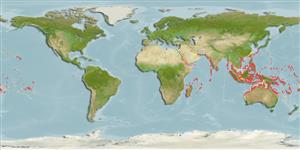Environment: milieu / climate zone / depth range / distribution range
ນິເວດວິທະຍາ
ສັດທະເລ; ນ້ຳກ່ອຍ ກ່ຽວກັນຫີນ; ລະດັບຄວາມເລິກ 1 - 30 m (Ref. 1602). Tropical; 30°N - 28°S, 32°E - 139°W
Indo-Pacific: East Africa to the Tuamoto and Austral islands, north to the Ryukyu Islands, south to New Caledonia.
Length at first maturity / ຂະໜາດ / ນ້ຳໜັກ / Age
Maturity: Lm ?, range 26 - ? cm
Max length : 45.0 cm TL ຕົວຜູ້/ບໍ່ມີເພດ; (Ref. 9710)
ຄີ (ໜາມ)ແຂງຢູ່ຫຼັງປາ (ທັງໝົດ): 9; ຄີຫຼັງຂອງປາ (ຄີອ່ອນ) (ທັງໝົດ): 10; ຄີ(ໜາມ) ແຂງຢູ່ຄີກົ້ນປາ
ກຸ່ມປາກະດູກແຂງ
ຄວາມຖີ່ຂອງກຸ່ມຖ່າຍທອດພັນ
ປາທີ່ມີການເຄື່ອນຍ້າຍຈາກທະເລໄປຫານ້ຳຈືດ ແລະນ້ຳຈືດຫາທະເລ
ປາທີ່ມີການເຄື່ອນຍ້າຍຈາກທະເລແລະໄປໄຂ່ຢູ່ນ້ຳຈືດ
ຄີກົ້ນຂອງປາ
ສັດທີ່ມີກະດູກສັນຫັຼງ
ການຖ່າຍທອດທາງກຳມະພັນຈາກພໍ່ແມ່ຫາລູກ 3; ຄີກົ້ນຂອງປາ: 8. This species is distinguished by the following characters: body moderately deep, its depth 2.3-2.6 times in standard length; dorsal profile of head convex; anterior tip of snout forming an acute angle; jaws prominent, 2 strong canines situated anteriorly in each jaw; no enlarged tooth present of rear of upper jaw. D IX,10, the spines and anterior soft rays of similar length; A III,8; pectoral fins with ii unbranched and 10 branched rays; pelvic fins long, reaching anus in small fish, well beyond in adults; centre of caudal fin rounded in adults, with the upper and lower rays forming elongate lobes giving the fin a trilobed appearance; lateral line interrupted below posterior portion of dorsal-fin base, with a total of 22-23 pored scales; scales reaching well onto bases of dorsal and anal fins; scales in front of dorsal fin extending forward to above centre of eye; cheek and opercle scaly; lower jaw without scales. Colour of the body variably pigmented from green to brown with mottled purple and red markings; 4 vertical dark bars on body that are often indistinct on large individuals; head with numerous small red spots; red lines radiating from anterior and posterior of eye; scales on sides each with a vertical, slightly curved red line; dorsal, anal, and pectoral fins yellow or green with distal red streaks; caudal fin green with a red posterior margin; juveniles with 3-4 dark spots midlaterally on sides and more prominent dark bars. This species capable of rapid colour changes (Ref. 9823).
Adults inhabit lagoon and seaward reefs at depths of 1 to over 30 m, and relatively common along shallow reef margins with good coral cover (Ref. 9710). Usually solitary (Ref. 5213). Feed mainly on shelled benthic invertebrates such as mollusks and crustaceans, but occasionally take fishes (Ref. 1602). Oviparous, distinct pairing during breeding (Ref. 205). Difficult to approach (Ref. 9710). Juveniles secretive on algae reefs and usually around stinging hydrozoans (Ref. 48636).
Life cycle and mating behavior
ການຈະເລີນເຕັມໄວ | ການສືບພັນ | ການວາງໄຂ່ | ໄຂ່ | ຄວາມດົກຂອງໄຂ່ປາ | ຕົວອ່ອນ
Oviparous, distinct pairing during breeding (Ref. 205).
Westneat, M.W., 2001. Labridae. Wrasses, hogfishes, razorfishes, corises, tuskfishes. p. 3381-3467. In K.E. Carpenter and V. Niem (eds.) FAO species identification guide for fishery purposes. The living marine resources of the Western Central Pacific. Vol. 6. Bony fishes part 4 (Labridae to Latimeriidae), estuarine crocodiles. FAO, Rome. (Ref. 9823)
IUCN Red List Status (Ref. 130435)
Threat to humans
Harmless
Human uses
ການປະມົງ: ທີ່ເປັນການຄ້າໜ້ອຍ; ຕູ້ປາ: ເປັນສີນຄ້າ
ຂໍ້ມູນຕື່ມອີກ
ເອກະສານອ້າງອີງການລ້ຽງສັດນ້ຳຂໍ້ມູນການລ້ຽງສັດນ້ຳສາຍພັນກຳມະພັນElectrophoresesການຖ່າຍທອດທາງກຳມະພັນຈາກພໍ່ແມ່ຫາລູກພະຍາດການປຸງແຕ່ງNutrientsMass conversion
ເຄື່ອງມື
Special reports
Download XML
ແຫຼ່ງອີນເຕີເນັດ
Estimates based on models
Preferred temperature (Ref.
123201): 25.2 - 29.3, mean 28.4 °C (based on 3095 cells).
Phylogenetic diversity index (Ref.
82804): PD
50 = 0.5078 [Uniqueness, from 0.5 = low to 2.0 = high].
Bayesian length-weight: a=0.02239 (0.01578 - 0.03176), b=2.95 (2.85 - 3.05), in cm total length, based on LWR estimates for this species (Ref.
93245).
ຊັ້ນເຂດຮ້ອນ (Ref.
69278): 3.9 ±0.2 se; based on diet studies.
ຄວາມຢືດຢຸ່ນ (Ref.
120179): ຂະໜາດກາງ, ປະຊາກອນຕຳ່ສຸດທີ່ໃຊ້ເວລາສອງເທົ່າ 1.4 - 4.4 ປີ (Preliminary K or Fecundity.).
Fishing Vulnerability (Ref.
59153): Low to moderate vulnerability (35 of 100).
Nutrients (Ref.
124155): Calcium = 35.7 [18.4, 61.7] mg/100g; Iron = 0.581 [0.245, 1.126] mg/100g; Protein = 17.8 [13.6, 21.1] %; Omega3 = 0.0833 [, ] g/100g; Selenium = 30.6 [15.1, 62.7] μg/100g; VitaminA = 137 [21, 863] μg/100g; Zinc = 2.5 [1.4, 3.5] mg/100g (wet weight); based on
nutrient studies.
